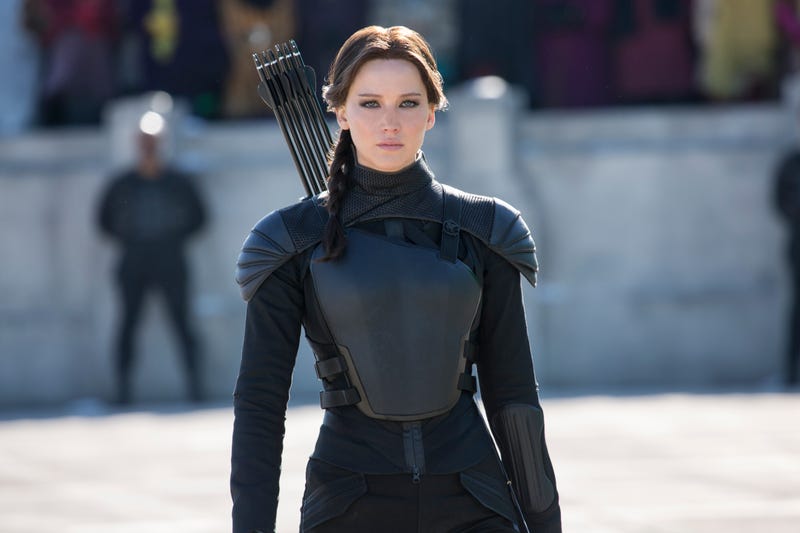When The Hunger Games movie came out in 2012, the world was set on fire. Jennifer Lawrence became a superstar, the books stayed on bestseller lists for months, and another three films were quickly announced. The prequel story based on the newly released book of the same name, The Hunger Games: The Ballad of Songbirds and Snakes, is winging its way to theatres this November. But do the original films hold up, over a decade later?
Absolutely, they do. Honestly, the first film might be even better than I remembered it. Maybe it’s the nostalgia talking (I was a Hunger Games fan, even more so than other famed YA franchises at the time), but as I rewatched the 2012 release, I realized just how smart and effective the movie was. It takes a political stance without being preachy, talks about oppression and resistance without flinching, and features main characters who are practical and direct, all without speaking down to its audience.
There’s also a slowness to The Hunger Games that’s hard to find in contemporary movies. The cinematography makes the film feel timeless in a way that many contemporary action and YA films now won’t be able to replicate. There are long shots of mountain ranges, a focus on details, and character development without pressure to say something in the scene, instead fleshing out the people we’re supposed to be caring about with efficiency and empathy. We believe what this series is saying about Katniss, Peeta, and Gale. They are understandable characters; they feel real in a way that many films aimed at young adults don’t feel real. It is a genuinely fantastic film.

The three sequels—Catching Fire and Mockingjay Parts 1 and 2—were buoyed by powerhouse acting from people like Donald Sutherland (President Snow), Julianne Moore (Alma Coin), Stanley Tucci (Caesar Flickerman), Philip Seymour Hoffman (Plutarch Heavensbee), and Woody Harrelson (Haymitch Abernathy). But possibly the best thing about The Hunger Games franchise is that the sequels don’t sacrifice what made the first film great in an attempt to up the stakes. Instead, they iterate on the themes, creating tension in the characters that we have already become attached to. One of the very first scenes of The Hunger Games: Catching Fire shows Katniss experiencing the repercussions of surviving the 74th Hunger Games—her PTSD coming to the fore, depicting clearly the effects of these dystopian scenarios in a way that had, for a long time, been glossed over in favour of chosen ones saving the world.
The franchise had the benefit of working from a trilogy that was incredibly smart and well-written, and the movies rarely deviated from the source material. Despite that, the films don’t rest on the laurels of the books, elucidating the themes smartly and effectively. The movies trusted the audience to understand what was going on, and didn’t try to soften the brutal, sharp edges of the series. As revolution foments, the plot continues to turn inward, eviscerating the underpinnings established in the first film rather than attempting to expand beyond the boundaries of the books. The villains at the beginning of the series are different than the villains at the end, but the fight stays the same. Oppression must be met with revolution, truth is a powerful thing, and sometimes love is not enough. Sometimes, it shouldn’t be.

While the split of Mockingjay was probably to its detriment, both films were still solid instalments in the series, and the ending was as unhappy as it should have been. There was a sadness to The Hunger Games that was necessary to its storytelling, and the two Mockingjay films brought home the horror, the system-led terror, and fear that ran throughout the series. Maybe it’s because the two-part Mockingjay wasn’t as strong as it could have been, and probably not as strong as either the first film or Catching Fire, that The Hunger Games became a cultural footnote in the middle 2010s, lumped in with other YA series like Divergent and Maze Runner, when it was the contemporary master and originator of the tropes that those stories continued to iterate on.
There is no way that I can say that The Hunger Games films were underrated. It was a movie event every year from 2012 to 2014, and the original four-film franchise made nearly three billion dollars. But these films still seem relegated to YA audiences, an arena in the early 2010s that quickly became dominated by superheroes and Star Wars. The Hunger Games, much like its main characters, deserved better than it got, and while I don’t have high hopes for the new movie, the original four-film series is an exceptional exploration of systemic power, survival at any cost, and class divides that holds up even now, 10 years later.
This piece was written during the 2023 SAG-AFTRA strike. Without the labour of the actors currently on strike, the movie being covered here wouldn’t exist.
Want more entertainment news? Check out when to expect the latest Marvel, Star Wars, and DC releases, what’s coming to cinemas in Australia this year, and everything streaming this month across all platforms. Check out our dedicated Entertainment tab for more.
